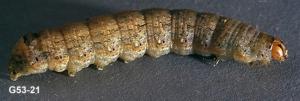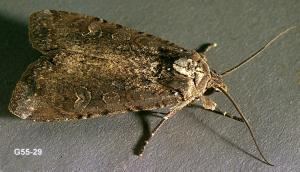|
Return to:
[Variegated
Cutworm Identification]
[Insect
Management]
[Home]
|
|
 |
 |
| Variegated Cutworm Larva (5th instar) |
Variegated Cutworm Adult |
Foliage feeding cutworms and armyworms include the
variegated cutworm and other foliage-feeding cutworms such as spotted
cutworm, Amathes c-nigrum, western yellowstriped
armyworm, Spodoptera praefica, olive green cutworm,
and the Bertha armyworm. These different cutworm species may
occur together in the same field during July and early August. The sampling program and
treatment threshold described below for the variegated cutworm may also be used for the
aggregate of these species.
Sampling
For variegated cutworm, inspect fields closely from mid-June
to just prior to harvest, remembering that if an insecticide application is considered,
the preharvest interval must be observed. Growers may want to consider harvesting earlier
to avoid further crop injury. Sweep net samples can be used to sample small larvae (first,
second, and third instars). Usually 10 straight line sweeps at 5 different sites in fields
up to 30 acres are sufficient to evaluate larval populations. Add an additional site for
every additional 10 acres. Largest collections of these smaller larvae will occur on cool,
overcast days, or when fields are sampled early in the morning or near dusk on still days.
Avoid sweep net sampling when mint is water-stressed or foliage is wet. Very often, more
than 50 per cent of the cutworms found in samples will be parasitized; this may alter the
treatment thresholds.
The decision to apply an insecticide is usually based on the average number of larvae
found per 1,000 sq cm (cm²)(an area slightly larger than 1 sq ft) on the soil surface. To
estimate larval populations of fourth, fifth, and sixth instars, inspect the soil surface
by first vigorously shaking mint foliage and closely observing and recording the number of
larvae per 1000 cm² randomly through the field. Take a ground search sample every 5 acres
for fields up to 30 acres. Add an additional site for every 10 acres in fields that exceed
30 acres. Look very closely for small and curled-up larvae under and in folded leaves on
the ground. Remember that larvae can fall into cracks on the soil surface. When
leaf-chewing is quite evident and cutworm counts from ground searches are low, consider
returning after dark and sampling with a sweep net when the larvae actively feed on the
foliage.
Sequential sampling plans have been
developed for variegated cutworm using sweep net samples to estimate larvae (instars 2 to
4) and for ground search samples (1000 cm²) to estimate larval instars 4 to 6 (Coop, 1987). Using these plans, treatment of larval instars 2 to
4, sampled with a sweep net, is recommended if 60 larvae are collected from a minimum of
11 different field sites (a minimum of 10 sweep net samples should be taken at each site).
Treatment is not recommended if fewer than 44 larvae are collected in sweep net samples.
For ground search sampling, treatment of larval instars 4 to 6 is recommended if 24 larvae
are collected in 1000 cm² samples taken from a minimum of 18 different sites. Treatment
is not recommended if fewer than 17 larvae are collected in the 1000 cm² samples.
A sex pheromone is commercially available and can be used to detect and monitor adult
males of the variegated cutworm in the spring. Trapping males could provide valuable early
season information to growers concerning the potential need to control cutworm larvae
during June and July (Coop, 1987). Sticky traps baited with
this lure can be set in fields in late April and monitored weekly or biweekly through
June. Although action levels for an insecticide or Bt treatment have not been developed
based on moth catches, it is likely that large and continual catches greater than 25 per
week will result in similarly large populations of larvae being observed approximately 2
weeks following peak trap counts. The real value of pheromone traps lies in the fact that
they signal when to begin inspecting fields for larvae, thereby greatly improving timing
of an insecticide application, if one is necessary. Also be aware that, occasionally,
large trap catches will not result in large larval populations. This is particularly true
when the mint field does not have a resident population of variegated cutworm and the trap
catches are a result of males being lured into traps from other crops. Conversely, a small
trap catch does not necessarily mean that an action level will not be exceeded by the
larvae.
Biological Control by parasitoids
Naturally occurring predators and parasites play an
important role in suppressing cutworm populations throughout all mint-growing areas in
Oregon. The percentage of parasitism may reach 80 to 90 per cent in some fields. The
principal parasites of cutworms and loopers on mint are Meteorus communis, Nepiera
spp., Campoletis spp., and Copidosoma spp. (Coop,
1987; Coop and Berry, 1986). Growers and consultants
are urged to consider that it is likely that a significant proportion of the larvae in
samples may be parasitized. Leaf consumption by parasitized larvae is much reduced and
there is very little reduction in oil yield caused by these larvae (Coop and Berry, 1986). Parasitized larvae can be
distinguished from nonparasitized larvae only by dissection. Select some of the largest
larvae from the sweep or ground search sample. With each, cut the head off, and pull the
larva apart. If the larva is parasitized, another smaller larva of the pasrasite will be
found inside the cutworm larva. If time permits, larvae can be reared in the laboratory to
determine the number parasitized. Depending on the percentage of larvae parasitized, you
can increase the suggested action thresholds, or avoid treatment all together.
If treatment is justified, refer to the registered insecticides section for a list of
insecticides and rates that are registered for use on mint to control cutworms. Orthene
generally has been more effective in controlling larger cutworm and looper larvae and
grasshoppers. Lannate controls smaller larvae and has been shown to prevent egg hatch in
laboratory studies and field observations in other crops. Lannate also satisfactorily
controls populations of adult mint flea beetle when present at the time of application --
Orthene does not. Research has shown that variegated cutworm feeding on peppermint is less
susceptible to insecticides because the terpenes found in mint leaves induce enzymes that
detoxify the insecticides (Berry et al., 1980). On the
other hand, certain peppermint terpenes have been shown to increase mortality of
variegated cutworm larvae and pupae (Harwood, 1987; Harwood et al., 1990).
Bacillus thuringiensis (Bt) applied at 1 to 2 quarts/acre can reduce populations
of small cutworms. It benefits from the addition of a spreader sticker or wetting agent
and is more effective if applied at night, when larvae are actively feeding on foliage
being sprayed, and in the absence of direct sunlight and extreme temperatures. It does not
control pests other than loopers, cutworms, and armyworms. Activity on variegated cutworm
and other cutworms and armyworms is variable, depending on the trade product and its
formulation. The major disadvantage of the use of Bt is the fact that the dense mint
foliage prevents penetration and coverage of the leaves with Bt.
Entomopathogenic nematodes have recently been tested and may provide control of variegated
cutworm in peppermint, if applied properly to coincide with susceptible stages of the
larvae (Berry et al. 1993). |


